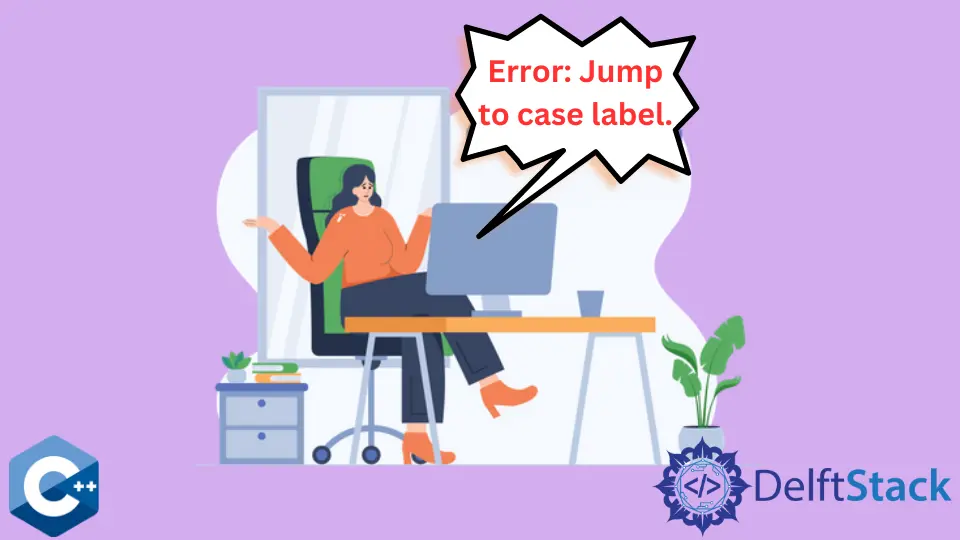How to Jump to Case Label in the switch Statement

This article will discuss the use of switch statements in C++. Moreover, it will discuss errors that may arise while using the switch statement, including the Jump to case label error.
the switch Statement in C++
The switch statement evaluates a given Boolean or integer expression and executes the statement(s) associated with the cases based on the evaluation of the given expression. It is the best alternative to the lengthy if-else-if statements as it reduces the code length and enhances clarity.
In C/C++, the following syntax is used for the switch statement to perform the evaluation.
Syntax:
switch (exp) {
case a:
// Block of code
break;
case b:
// Block of code
break;
default:
// Block of code
}
The switch statement works in the following way:
- The expression is evaluated once in the
switchstatement. - The
casevalue is compared to theswitchvalue. - After evaluating the
switchexpression with acasestatement, the block of code subsequent to the matchedcaseis executed if the condition is true. - The
breakanddefaultkeywords are optional with theswitchstatement. We’ll discuss these in detail at the end of this tutorial.
Suppose we want to calculate the weekday name from the weekday number.
Example Code:
#include <iostream>
using namespace std;
int main() {
int weak_day = 3;
switch (weak_day) {
case 1:
cout << "Monday";
break;
case 2:
cout << "Tuesday";
break;
case 3:
cout << "Wednesday";
break;
case 4:
cout << "Thursday";
break;
case 5:
cout << "Friday";
break;
case 6:
cout << "Saturday";
break;
case 7:
cout << "Sunday";
break;
default:
cout << "Invalid input";
}
}
Output:
Wednesday
the break Keyword
The break keyword is used with a switch statement to skip the remaining cases of the switch body after a given case is met.
In the above example, when the switch statement is evaluated and meets the criteria in case 3, it skips the remaining code block of the switch body due to the break; statement.
the default Keyword
The default keyword is used with the switch statement to execute a specified block of code when none of the cases is met in the given switch statement.
Let’s look at the following example, which demonstrates using the default keyword in the switch statement.
Example Code:
#include <iostream>
using namespace std;
int main() {
int a = 4;
switch (a) {
case 6:
cout << "Value of a is 6";
break;
case 7:
cout << "Value of a is 7";
break;
default:
cout << "The number is other than 6 or 7";
}
}
Output:
The number is other than 6 or 7
In this example, we have specified the value of the integer variable as 4, but none of the cases will satisfy the given condition during the execution. Therefore, the default block is executed.
Fix the Jump to case label Error in the switch Statement in C++
A common error that may arise while using the switch statement is a Jump to case label error. The error occurs when a declaration is made within/under some case label.
Let’s look at the following example to understand the issue:
#include <iostream>
using namespace std;
int main() {
int a = 1;
switch (a) {
case 1:
int i = 66;
cout << i;
break;
case 2:
cout << i * 3;
break;
default:
cout << "Looking forward to the Weekend";
}
return 0;
}
In the above example, when we initialize i=66 in case 1: and execute the code. The code generates an error Jump to case label as the value of i is visible to the other cases.
A case is just a label and therefore doesn’t restrict the scope of the code written next to it. Hence, if case 2 is executed during execution, i will be an uninitialized variable.
So, a strongly typed language like C++ will never allow this to happen. Thus, it generates a compile-time error.
The scope delimiters {} within case 1 can overcome this scope issue and help execute the code without error.
#include <iostream>
using namespace std;
int main() {
int a = 1;
switch (a) {
case 1: {
int i = 66;
cout << i;
break;
}
case 2:
cout << "value does not exist";
break;
default:
cout << "Looking forward to the Weekend";
}
return 0;
}